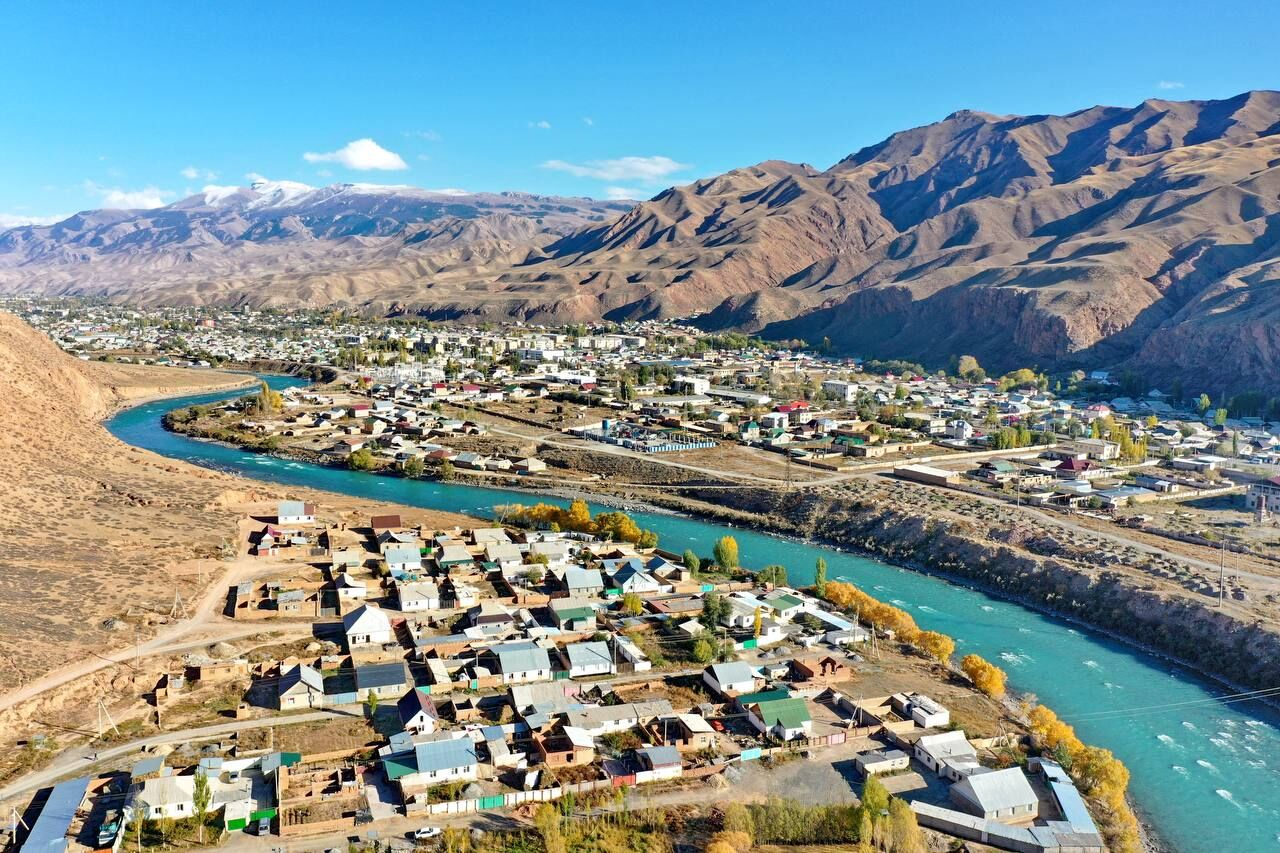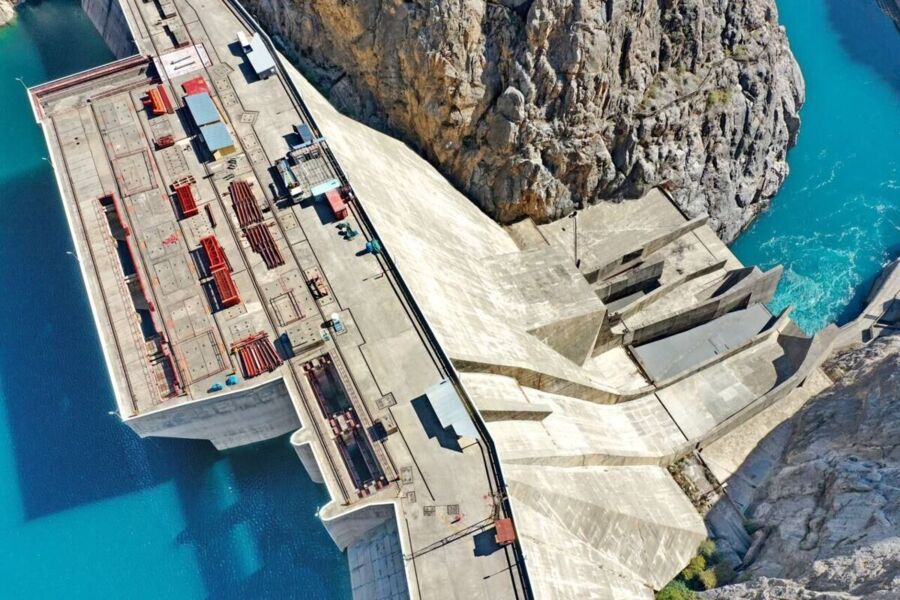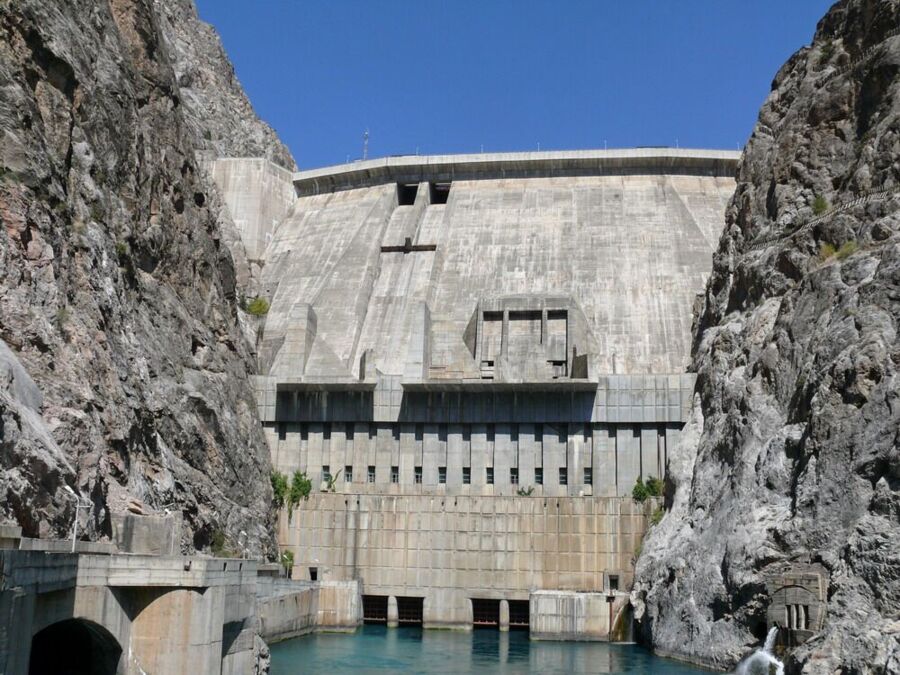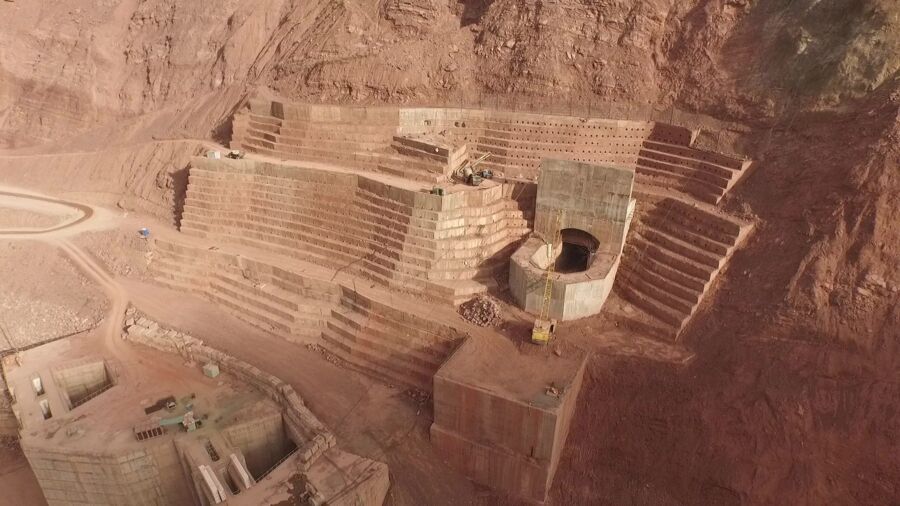First envisioned during the Soviet era, the Kambar-Ata-1 dam and a hydropower plant (HPP) on the Naryn river in Kyrgyzstan might finally be built, after Kazakhstan, Kyrgyzstan, and Uzbekistan signed an agreement on April 15 establishing a joint company to start construction.
Осы мақаланың қазақша нұсқасын оқыңыз.
Читайте этот материал на русском.
According to experts surveyed by Vlast, this massive project, which will add 40% to Kyrgyzstan’s existing hydropower generation rate, is likely to be completed later than the 15 years the parties envision. And it could cost more than the $5-6 billion that Kyrgyz President Sadyr Japarov forecast in one of his speeches in April.
Last year, Kyrgyzstan produced 13.8 billion kWh of electricity, according to the Kyrgyz Energy Settlement Center. Because of chronic shortages, Kyrgyzstan also had to import a total of 3.5 billion kWh, mostly from Kazakhstan, in 2023. With a projected capacity to generate 5.6 billion kWh, the Kambar-Ata-1 HPP could improve Kyrgyzstan’s energy security and allow for increased exports.
The Long Run
The Kambar-Ata-1 project was first planned during the late Soviet period, within the framework of water cooperation between upstream (Kyrgyzstan) and downstream (Kazakhstan and Uzbekistan) republics. After independence, the project was shelved due to its high price tag.
The Kyrgyz government later tried to revive the project, also with the help of Russia, but plans fell through.
Now, the trilateral agreement could spearhead construction and push the three countries to obtain international financing in an effort to reach a milestone in regional energy security.
The agreement, signed in Bishkek, sees Kazakhstan (33%), Kyrgyzstan (34%), and Uzbekistan (33%) co-owning the company responsible for the construction. The parties will maintain this corporate structure until construction work is complete, after which the ownership of the dam and HPP will pass on to Kyrgyzstan.
There will be long term implications for Kyrgyzstan’s energy security once the project is completed, according to Rahat Sabyrbekov, a visiting scholar at Harvard’s Davis Center and a researcher at the OSCE Academy in Bishkek, who focuses on energy transition and cooperation in Central Asia.
“Seasonality, outdated infrastructure, and lack of cooperation were the main reasons that a region rich in resources would experience energy deficits. Central Asian countries now came to the realization that they need each other not only in terms of water cooperation, but also in terms of energy security,” Sabyrbekov told Vlast.
A Paradigm Shift
For decades, after the fall of the Soviet Union, the chief naysayer to any new project that would change the equilibrium of water supplies in Central Asia was Uzbekistan’s first President, Islam Karimov.
Since his death in the summer of 2016, several hydropower projects in neighboring countries could be kick-started, argued Sabyrbekov.
“When Kyrgyzstan and Tajikistan tried to build dams for smaller HPPs, Uzbekistan in retaliation cut off gas supplies. It was only after President Karimov died that Uzbekistan’s strategy towards water resources and energy cooperation changed. Now, on the contrary, Mirziyoyev promotes building joint power plants,” Sabyrbekov told Vlast in an interview.
Shavkhat Mirziyoyev served as Karimov’s prime minister for more than a decade before becoming president in 2016. Just one year into office, he loudly stated Uzbekistan’s willingness to build the Kambar-Ata-1 dam and HPP together with Kyrgyzstan.
Filippo Costa Buranelli, a senior lecturer at the University of St. Andrews focusing on regionalism in Central Asia, told Vlast that this was one of the first signs of cooperation among Central Asian states.
“Agreements of such nature have been taking place in the region in the past few years. Kazakhstan and Kyrgyzstan have been discussing joint projects in water matters for a few years as well. That the three states have moved beyond issues of levels and quotas and have started talking about investments, infrastructure, and joint projects is quite significant,” Costa Buranelli said.
Filippo Menga, an associate professor at the University of Bergamo who focuses on water politics, urged caution, given the distance between signing an agreement and the implementation of a project
“Only time will tell. It’s worth remembering, however, that riparian relations in the region have been volatile, and there are other similar cases where regional agreements have come close to being signed, only to be canceled,” Menga told Vlast.
A Diplomatic Coup
Menga noted that the agreement “is certainly surprising, considering how controversial large hydropower plants have been in the region since 1991.” The diplomatic work that the countries involved have put together, especially since 2016, seems to be paying off now.
“Kazakhstan has been quite active in water cooperation recently, for example co-organising with the French government the One Water Summit on the sidelines of the next high-level session of the 79th UN General Assembly,” Menga said.
At once “surprising” because of the progress being made and “unsurprising” because of the small steps that preceded the agreement, the construction of the Kambar-Ata-1 dam and HPP can be considered a diplomatic coup for the three countries.
Something has definitely shifted in recent years, Costa Buranelli told Vlast.
“The paradigm of relations on these matters has changed. From adversarial competition, we are moving towards mutually beneficial cooperation. And this agreement is proof that water diplomacy is now working in Central Asia.”
Multilateralism and Connections
In October last year, the World Bank approved the financing of a $5 million technical assistance package for the Kambar-Ata-1 project.
“The Kambar-Ata-1 HPP is a critically important project that has the potential to bring huge benefits in clean energy generation, regional cooperation, water security, and environmental safeguards across Central Asia,” World Bank regional director for Central Asia Tatiana Proskuryakova said.
The World Bank had already bet on electricity projects across Central Asia, the most notable of which is perhaps the ambitious CASA-1000 power line. Through this project Tajikistan and Kyrgyzstan would provide electricity to Afghanistan and Pakistan, matching available supply in the upstream countries with chronic deficit in the two South Asian countries.
CASA-1000 had been in the books for years, despite infrastructure issues in Tajikistan (with the sluggish construction of the Rogun HPP) and Kyrgyzstan (with seasonal electricity deficit), as well as doubts concerning Afghanistan, where the Taliban’s takeover in 2021 put the entire project to a halt. In February, almost three years later, the World Bank decided to resume funding for CASA-1000, breathing new life into a project that had struggled to find other private investors.
“The plans for Kambar-Ata-1 perfectly align with the CASA-1000 project. There has been a long criticism of the latter because there was not enough electricity to export. [Without Kambar-Ata-1 HPP,] CASA-1000 would only be feasible through the rationing of electricity in the exporting countries,” Sabyrbekov told Vlast.
Given that CASA-1000 is poised to rely mostly on Tajikistan – which will provide 70% of the electricity, while Kyrgyzstan will provide the remaining 30% – the Kambar-Ata-1 HPP will not be enough to make it feasible.
“Tajikistan is building another large dam, Rogun, and if and when – and I stress if and when – these two dams are completed, the CASA-1000 project will finally make sense. However, CASA-1000 makes it clear that the priority for the governments of Tajikistan and Kyrgyzstan is likely to be selling energy abroad rather than redistributing it to their citizens,” Menga told Vlast.
Sabyrbekov is also skeptical regarding the timeline of the project.
“Based on all the infrastructure projects we have seen in the region, it will take much longer than scheduled. It’s the first time that countries came together to build something, and it might take time to adjust to each other. International financing is another issue, because the World Bank is not known for being on time with payments,” Sabyrbekov said, citing several other precedents of halted or canceled projects and the potential for the price tag to increase.
Manufacturing Ecosystems
Large-scale hydroelectric projects inevitably have an effect on the ecosystems and the societies living in the proximity of the water basins.
According to Menga there could be a tension between the need to fill the prospective dam as soon as possible and the potential effect on the local population.
“There will be a reduction in water flow during the years it takes to fill such a large reservoir. The longer it takes to fill the reservoir, the smaller the resulting reduction in water flow downstream. Clearly, the commissioning states have an interest in filling the reservoir as quickly as possible to start producing hydroelectricity. And there might be consequences, for farmers and all those who rely on the flow of the Naryn river,” Menga told Vlast.
Timur Nusimbekov and Malika Autalipova, the founders of the Adamdar.ca multimedia project, have worked on the JerSu (Earth-Water) documentary project, visiting all the main water sources of Central Asia, including the Naryn river. They argued that the new power station could bring undeniable benefits in terms of energy security for the three countries, but warned of potential pitfalls.
“It is important that when designing, constructing, and operating such a large-scale facility as Kambar-Ata-1, all modern criteria and standards of technical and environmental safety, as well as the environment and the people in the region, are taken into account,” Nusimbekov and Autalipova told Vlast.
Corruption is also a worrisome element that could play against the completion of the project.
“It is crucial that the hydroelectric power station is at all stages maximally protected from corruption and incompetent management. The influence of corruption and incompetence can be no less destructive than fires, floods, and global warming,” Nusimbekov and Autalipova said.
Поддержите журналистику, которой доверяют.












